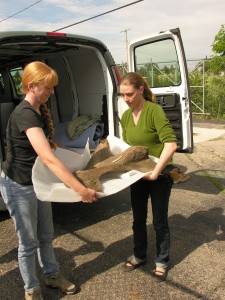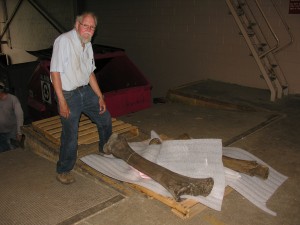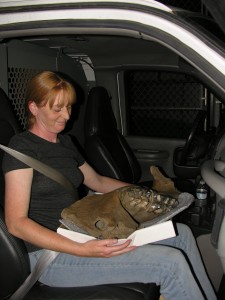
Kellie Locke-Rogers and Juli Six moving a partial mammoth pelvis.
What is the largest and heaviest object to move in all of the natural history collections? A mastodon! And what did we recently get to move across town, on short notice? A mastodon! In fact, two mastodons were on the move recently in Columbus.
The Orleton mastodon is a mostly complete, disarticulated skeleton that was one of many specimens that remained at Ohio State when our museum left the campus and moved to the current building in 1970. It still belonged to the Ohio History Connection but was kept at OSU for research purposes. To learn more about the history of the Orelton mastodon, see Bob Glotzhober’s article on this skeleton – in a blog post from Jan. 14, 2013.

This all started a few weeks ago when we got a call from Dale Gnidovec, Curator of the Orton Geological Museum at OSU. He was given orders by OSU to move his mastodon skeleton which was being housed in Mendenhall Lab. As is a too common event on college campuses, the space was needed for offices and so fragile, important museum collections have to move. Even hard to move collections like mastodons! The only space that Dale had for his mastodon was the room occupied by our Orleton mastodon. Our mastodon had to come back home, and Dale’s mastodon had to move out of Mendenhall Lab. Thus begins the game of “musical mastodons”.

Kellie demonstrates the safest way to move a mastodon mandible.
The Orleton skeleton was pretty broken up when originally recovered. One theory to explain the fragmented nature of the skeleton was that bones were trampled by other mastodons who came to the same location for water in subsequent years. Trampling of bones by modern elephants has been documented to occur by researchers in Africa. A few Orleton bones were complete, but the skeleton was in over 2400 individual pieces! So we ended up moving 57 boxes of material and 10 mostly complete large bones. Five of the boxes were of other interesting specimens that needed to be returned to OHC including a fragmented skeleton of an early horse, a huge box of antlers from several elk that were recovered from Silver Lake in about 1961, and a few long bones of a mammoth.
Thanks to everyone who helped with the move: Linda Pansing, Kellie Locke-Rogers, and Juli Six of the OHC Archaeology Unit; and to Bill Schultz, former Curator of Natural History and current volunteer.
How many van loads do you think it took to move one mastodon, one partial mammoth, and the other specimens!?